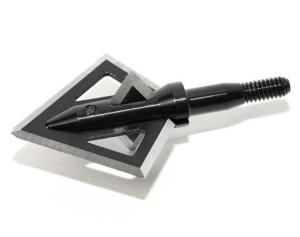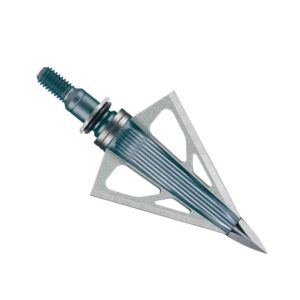Best Broadheads for Deer: A Clean, Precise, and Accurate Kill
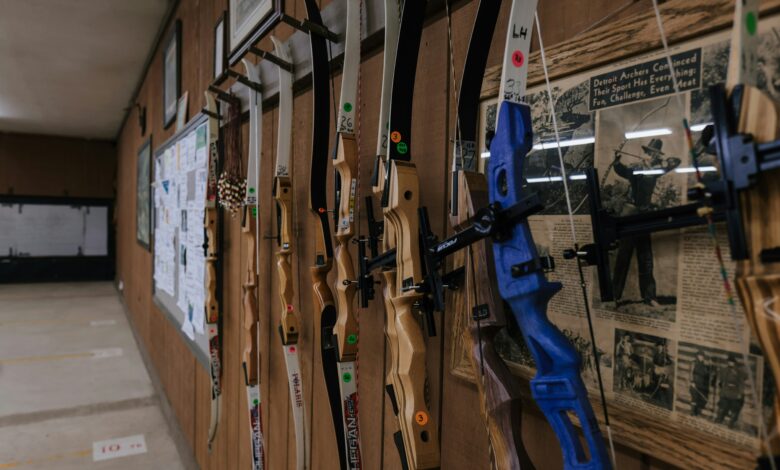
I find the idea of testing new broadheads is pretty exciting. But even after switching between multiple broadheads every year for the last fifteen years, I have not been able to check out all the top performers in the market. There are an insane number of options out there with new ones coming up at frequent intervals.
With multiple factors influencing the choice of a broadhead, things can get more challenging for newbie hunters. In short, the equation for finding the perfect broadhead is complex.
To help you narrow down the choice, we have picked 8 of the best broadheads for deer. Our tests have proved them to be incredibly dependable and lethal as well.
Why Trust CarbonTV About Hunting Broadheads?
At CarbonTV, we have arrows being tested in our backyard almost every day. When put together, our team of bowhunters has more than five decades of hunting experience. Beyond that, we consult with industry-leading professionals as well as certified archery instructors for their opinions on the subject.
We picked 20 broadheads from the market that rank high on the reputation scale. Then we set up our own testing mechanism to test them for durability, sharpness, penetration, and flight performance.
That included using ballistic gel blocks combined with a piece of thick carpet for penetration tests. Then we shot each of these heads 3 times into a 22-gauge steel plate to test durability.
We know that technical parameters do not tell the full story on their own. So we focused on actual user feedback as well. Finally, we compared the overall performance to list out the best ones.
Judging performances based on multiple parameters was not easy, but it was a ton of fun.
Best Broadheads for Deer
Here are the eight best broadheads for deer that were the top performers for us.
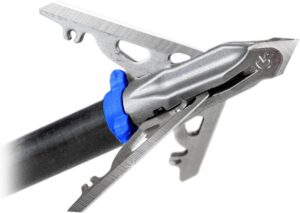
1. G5 Deadmeat V2 – Best Broadhead Overall
Pros
- Heavy duty blades
- A Snaplock collar
- Solid penetrating power
Cons
- The blade angle could be more streamlined
Known for its large wound channel and sharpness out of the box. It’s a rear-deploying mechanical broadhead available in 100 or 125 grains.
With its unconventional three-blade design and 100% stainless steel blades, the V2 Deadmeat is an expertly designed broadhead that delivers solid knockdown power. The new version is a definite improvement over the previous one.
We loved the snaplock blade retention system which is super easy to use. Simply snap the blades in the slot and you are good to go.
Then there is the excellent performance in our penetration tests. It penetrated 8.2 inches in the ballistic gel medium and was the top performer. Even though the blades are compact, there was no bending or warping after penetration. The superior ferrule design reduces crosswind effects and the flight is stable.
In terms of accuracy, the Deadmeat excelled in our 40-yard tests. This head will shoot right where it is pointed. The 1-1/2″ cutting diameter works well for whitetails. Besides, the V2 is extremely forgiving and performs well even if your bow is not well-tuned.
I wish that the blade angles were more streamlined in the fully deployed position. That would have given it even more penetration power.
You can choose between 100 or 125 grains and it performs well right out of the box. Overall, the Deadmeat V2 is an excellent hunting tool that we wholeheartedly recommend as our top pick.
2. Magnus Black Hornet – Most Affordable
Pros
- Beefy design
- Designed for bigger wound channels
- Lifetime warranty
Cons
- Makes some noise
This budget-friendly option features a large wound channel and is easy to resharpen. It has a four-blade design and comes with a lifetime warranty.
While it has been around for a while, the design of the Magnus Black Hornet never fails to impress me. I love a beefy feel in a broadhead as much as the next hunter, but the combination of the main blade and the bleeder blade makes the Black Hornet look cool too.
The feedback about these broadheads is excellent and users mention heavy blood trails. The Hornet has a sharp sting right out of the box and I have seen them pass cleanly through bucks. The Black Hornet is available in 100, 12, and 150-grain versions and generates a 1 1/4“ wound channel.
In our retention tests, we shot the Black Hornet into a steel plate. While there was slight tip damage, the Hornet held up very well after three shots. Super impressive! It flies well too and the test performance was good.
Magnus does not mention any details about the metals used here. While the blades are made of solid steel, I suspect that the ferrule can be made of aluminum, However, that does not seem to affect the durability in any way.
Bonus: Magnus stands behind the lifetime warranty and the customer service is great. When you add on this fact, at this price point, the Black Hornet offers excellent value.
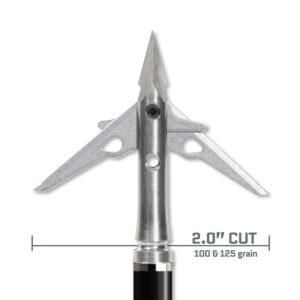
3. SEVR Titanium 2.0 – Best Mechanical Broadhead for Deer
Pros
- Large wound diameter
- Lock and Pivot blades
- Crossbow-friendly design
Cons
- Penetration can be affected by blade design
A highly accurate mechanical broadhead with pivoting blades to prevent deflection. Available in 100 or 125 grains with various cutting diameters.
The SEVR Titanium 1.5 has been one of my favorite broadheads for the deer rutting season. I expected the same top-grade performance from the Titanium 2.0 and it did not disappoint.
The combination of a titanium ferrule and stainless steel blades with a 2” cutting diameter makes this a great pick for big-bodied animals. The Lock-and-Pivot blades are a key feature that allows the blades to open and lock in place on impact. Even if you hit a bone, the blades pivot to ensure maximum penetration without deflection.
This mechanism also helped to keep the blades intact when we tested it on the steel plate. Compared to most other mechanical broadheads, the SEVR Titanium can withstand more shocks.
In our performance tests, the Titanium 2.0 delivered solid penetration with a penetration depth of 7.8”. There were no issues with blade deployment either. The broadhead is available in 100 and 125 grains variants and they feel heavy-duty. Since it is wider, the 2.0 is not as durable as the Titanium 1.5, but it still shines in terms of accuracy.
Another practical feature is the Practice Lock screw mechanism. While practicing, the screw prevents the blades from deploying. So, you can test the arrows for flight without running the risk of dulling the blades.
For whitetail and mule deer, the Titanium 2.0 is hard to beat. One concern is that one of the blades can swivel upon hitting a bone and make the hole smaller. Beyond that, the SEVR Titanim 2.0 hardly has any weaknesses when it comes to deer hunting.
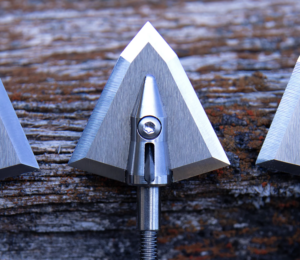
4. Iron Will S100 – Most Durable Broadhead
Pros
- Top-notch durability
- Super-quiet performance
- Comes with a maintenance kit
Cons
- A2 tool steel has low corrosion resistance
This fixed blade broadhead is known for its durability and excellent edge retention. It’s made from A2 tool steel and comes in various weights.
For starters, I admire the case that Iron Will provides with the arrows. While it is not a space saver, it makes storing the arrows easy. Made from .062” thick A2 tool steel, the broadhead feels solid and premium. It is precision crafted and each blade looks like a true beauty.
The special tempering process makes the blades incredibly hard and they have excellent edge retention as well. Even after rigorous tests, we found the blade retained sharpness. If you hit the right spot, the S100 will deliver smooth pass-throughs. They are also extremely forgiving and the accuracy was good too.
Iron Will mentions that the S100 is super quiet and we agree. There were hardly any blade hiss during flight, making them ideal for targeting skittish creatures. Iron Will has also added a bleeder blade to ensure a larger wound channel.
The chunky steel ferrule is robust, but look closely and you will find that it has a small lip. So I am a little worried that it might get caught on a bone while penetrating.
Then again, A2 tool steel is not as corrosion-resistant as stainless steel. So you must use some mineral oil, or blade care wax to keep the blades shiny. Thankfully, it comes with a kit that contains a polishing stone, an oil dispenser, and a cleaning cloth.
The S series arrows are available in eight weight options and you can also pick a Buff option without a bleeder blade. The S100 is not cheap, but if you are hunting big game, they are the real deal.
5. NAP Thunderhead – Best Fixed Broadhead for Deer
Pros
- Tough construction
- Effective ferrule design
- Shoots like field points
Cons
- Does not generate the best blood trails
A tried and true fixed blade broadhead that is sharp out of the box, easy to tune, and known for its reliability.
If you prefer the classic broadhead design, you will like the NAP Thunderhead. It has a cutting diameter of 1-3/16” and the chiseled tip is super sharp right out of the box.
The thickness of the blades is 0.027”. That does not make it as thick as some competitors. Still, it performed well in our durability tests though, and after three impacts with steel, there were some minor nicks on the blades. The edge retention was good and we were satisfied with the arrow flight too.
One excellent feature is the patented design of the micro-grooved ferrule. The air moving through the grooves helps in flight and also aids during penetration. The penetration distance was 6.4 inches and the generated wound channel was not the largest. Focus on accuracy when you are using the Thunderhead.
The Thunderhead has been around for a long time and is one of the fixed broadheads that has withstood the challenges of time. It comes in three weight options –125, 100, and 85 grains. Even with the old-school design, they can hold their own against the modern broadheads in terms of lethality.
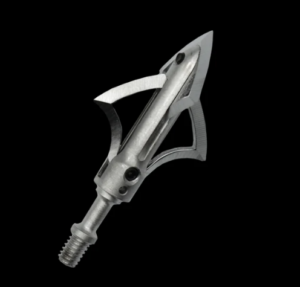
6. Evolution Outdoors Jekyll
Pros
- A reliable performer
- Multifunctional ferrules
- Practice heads are available
Cons
- Flight noise on the higher side
With solid reliability and top-notch durability, this broadhead features an innovative modular ferrule with stainless steel blades.
Even though Evolution Outdoors is a relatively new brand, the design of this broadhead speaks volumes of its expertise. The Jekyll is a four-bladed fixed-blade broadhead and one look at the pointy end will tell you that it means business.
The front blade and main blade are made from stainless steel and have a combined cutting diameter of 1.75”. Note that these broadheads are available in 100, 125, and 150 grain options and the 100 grain has ferrules made of 7075 aircraft aluminum. Admittedly, it is not super sharp to start with, but the wound channel generated was large enough.
Speaking of durability, the blades are 0.06” thick and the durability tests delivered excellent results. We tested the 100-grain option and other than a bit of edge chatter on the front blade, the broadhead remained undamaged.
A standout feature of the Jekyll is the patented multi-functional ferrule. This modular design allows you to swap the front blades with the 2-inch mechanical blades of another broadhead model from Evolution called Hyde. However, there is some flight noise, no matter the head weight you use.
I think Evolution Outdoors has got the equation right with this one. Frankly, I am eager to try the Jekyll out in my next hunt.
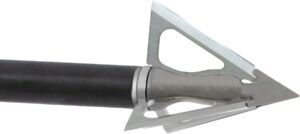
7. G5 Striker V2
Pros
- Great flight characteristics
- Good field point accuracy
- A quiet performer
Cons
- The wound channel is not the best
A replaceable blade broadhead that flies straight and is reliable for a takedown shot. It’s known for its minimal sound and precision.
The G5 Striker comes with a cool-looking blade that is made from steel and feels super durable. At first look we found the quality of machining to be impressive. And thanks to the machining, the Striker is excellent in flight. Even a simple spin test reveals how well-balanced the Striker is.
With the V2, G5 has updated the blade design by sharpening the angles and making the tail taller. It has also updated the blade locking mechanism by using a single thick washer. Most importantly, the cutting diameter has been increased to 1.25” to help increase the blood flow.
Beyond that, G5 has used Luitz blades that deliver superb sharpness and allow better penetration. That said, the performance in our penetration tests was good but not great. It penetrated 6.7“ in the tests.
The overall durability was good too. There were a few nicks on the blade edges after two shots in the steel block. However, since the blades are vented, we did not expect the durability to be on par with blades with solid construction.
All in all, the Striker V2 is one of the best whitetail broadheads you can pick. While it has a few drawbacks, none of them outshine the advantages.
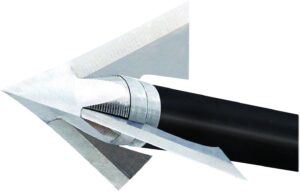
8. QAD Exodus
Pros
- Excellent durability
- Solid accuracy and penetration
- Leaves great blood trails
Cons
- The blades can cut fingers
This multi-piece broadhead is known for its destructive capability and replaceable blades. It features a wide cutting diameter and a sharp steel tip.
I was pretty excited about testing the QAD Exodus as I heard a lot of praise being heaped on it. After the tests, I was blown away by the performance. It turned out to be a super impressive performer without any serious drawbacks.
Perhaps the most impressive aspect of the Exodus was its sharpness. We have heard buyers nicking their fingers while unpacking these bad boys. So we were extra careful. The stainless steel blades are razor-sharp and the tip is super sharp too. The thickness of the blades is one of the best in class – 0.040 inches.
The Exodus recorded an excellent penetration depth of 7.7 inches. Thanks to the wide tip and a cutting diameter of 1-1/4 inches, the wound channel was big too.
What caught my eye was that the angle of the tip on the Exodus matched that of the blades. This design prevents the blades from flaring out and gives the broadhead an aerodynamic advantage.
Another key feature is the blade-over-shaft design with an extremely small ferrule. This keeps the ferrule from getting damaged and also ensures a good flight. After going through the durability test the tip and the blade edges remained undamaged. All I could see were a few scratches.
Make no mistake about it. The QAD Exodus is a killer and a very efficient one indeed. Admittedly this is one of the best broadheads that you can pick for big game animals.
How to Choose the Best Broadhead for Deer
Choosing a broadhead depends on several factors and you need to balance those that matter to you. Firstly, there are technical factors like arrow weight, draw weight, and draw length.
When you experiment with different broadheads, you know that no matter what you choose, shot placement matters. Whether you use a mechanical or a fixed blade broadhead, a direct hit in the lungs or the heart will kill deer.
For me, less-than-perfect shots are never entirely the broadhead’s fault. Either I chose the wrong broadhead for the job at hand or the shot placement was poor.
Broadhead Type
I have killed deer with both fixed blades and mechanical and choosing between the two is not an emotional subject for me. Besides, there have been situations where I have seen both types fail. It is somewhat like the issue of mule sheet vs whitetail deer. You need to know the differences and make the best use of them.
Hitting the right spot with a wide-cutting mechanical will ensure a better blood trail. With a lower drag factor, they are less affected by wind, and better choices while making long-range shots. You can also expect them to fly closer to field points.
On the downside, mechanical blades are unsupported and can break off due to heavy impacts. On the other hand, fix-blades are sturdier and can punch through the tough shoulder bones of the dear.
The debate between the two is never-ending but as long as you are confident about making the perfect hit, any good-quality broadhead should serve the purpose.
Weight
The weight of the arrow you choose depends on the type of hunting you plan to do. For whitetails, a 100-grain arrow can get the job done. But when you are shooting at elk and moose, the arrow needs to penetrate the thick fall hides, and push through a large body cavity. This requires higher kinetic energy and momentum.
A higher grain weight raises the arrow’s momentum, increasing its penetrating power. And that helps when your shot is not perfect. Plus, a heavier broadhead increases the weight at the front end of the arrow (Often termed as front of center or FOC). This helps the arrow to cut through the wind more easily.
Let me guess. You are thinking – what about arrow speed and drop?
If you do the math, you will know that the heavier and slower arrows will generate more momentum than the faster and lighter arrows. Lighter arrows will have more kinetic energy, but in the end, the momentum with which the arrow impacts matters more.
Yes, the lighter arrow will drop less over longer distances. But when you are shooting within 40-50 yards, the difference is slight.
That said, for those with a draw weight of under 55 pounds, shooting a 100-grain arrow can be the better option. Otherwise, it is best to strive for maximum momentum generation and pick a heavier 125-grain broadhead.
Cutting Diameter
The general idea is that with bigger blades and more cutting diameter, you get larger wounds. But remember that larger blades can reduce penetration and increase the chances of the arrow being deflected by a bone.
That begs the question – do you want to sacrifice arrow penetration for a better wound diameter?
A broadhead with a 2-inch cutting diameter can give you a blood-soaked scene from a horror movie, but that does not make it more lethal. Not to forget, the damage inflicted depends on the cutting surface area of the arrow and the penetration depth.
Now, you may need a wide-cutting broadhead if you are hunting in dense cover. Otherwise, a 1-inch 4-bladed broadhead that penetrates deeper will cut through more blood vessels than a large-bladed one that penetrates 4 inches only. So, it is best not to get carried away by high cutting diameter numbers and consider other factors as well.
Durability
You do not want to pick a broadhead that becomes unusable after one kill. High-quality broadheads made from alloy steel or stainless steel are the best whitetail broadheads. These arrows do not break or bend, even if they hit a bone.
Beyond the fail-safe construction, the ultra-sharp blades of these arrows retain sharpness better. Also, the high-grade material makes them more corrosion-resistant. This makes it possible to use the arrows in adverse weather conditions, like shooting at deer moving in the rain.
Flight Performance
The first step towards improving flight performance is to ensure that your bow is well-tuned. Even the best broadhead will fail to hit the mark if the tuning is bad.
The next step is to pick a broadhead from a reputed manufacturer who understands the importance of tight tolerances. A smooth finish and perfectly proportional dimensions will make the broadhead fly better.
Coming back to arrow types, mechanical broadheads with lesser blade surfaces are less affected by air. In reality, the arrow type will not affect the flight path when shooting a whitetail at 30-40 yards. But as you increase the range, a poorly designed arrow will start showing its below-par flight characteristics.
Then again, cutting diameter impacts flight performance as well. In my experience, broadheads with a blade width between 1 1/8 to 1 3/16 inches have some of the best flight paths.
Price and Value
The quality of the broadhead that you are fixing on the pointy end of the arrow matters. Even an occasional hunter would prefer a durable broadhead with a consistent performance. So, going for cheaper options while sacrificing quality is not the right choice.
We have listed some broadheads that deliver a solid quality but are reasonably priced. A few even come with lifetime warranties. You will find them offering the best bang for your buck.
Final Thoughts
There you have it. A handpicked selection of the eight best broadheads for deer. Our aim is not to make head-to-head comparisons but to help you choose the best options.
Choosing the right broadhead is not simple, but ultimately, it comes down to picking one that you can depend on. It is important to judge a broadhead based on the performance parameters that matter most to you. That includes the type of game animal you are hunting and your bow setup.
But one thing is for sure. To tip the odds in your favor, you need to do the research and choose wisely.

